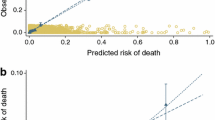Abstract
To evaluate the relationship between severity and nosocomial infection in critical patients, we have conducted a prospective study at the Intensive Care Unit of the University of Granada Hospital (Spain). Patients' severity was evaluated by APACHE II and TISS. We found a positive association with nosocomial infection risk for an APACHE II score greater than 12 points (RR=2.45) and for first-day TISS greater than 20 points (RR=2.51). With a multivariate analysis we did not find an association between APACHE II and nosocomial infection risk, but each TISS point suggests an infection risk increment of 6%. We concluded TISS may be considered a good infection risk predictor. TISS could also be taken into account when nosocomial infection rates from several ICUs are compared.
Similar content being viewed by others
References
Craven DE, Kunches LM, Lichtenberg DA, Kollisch NR, Barry A, Heeren TC, McCabe WR (1988) Nosocomial infections and fatality in medical and surgical intensive care unit patients. Arch Intern Med 148:1161–1168
Gross PA, Neu HC, Aswapokee P, Van Antwerpe C, Aswapokee N (1980) Deaths from nosocomial infections: experience in a university hospital and a community hospital. Am J Med 68:219–223
Daschner F (1985) Nosocomial infections in intensive care units. Intensive Care Med 11:284–287
Donowitz LG, Wenzel RP, Hoyt JW (1982) High risk hospital-acquired infection in the ICU patient. Crit Care Med 10:355–357
Wenzel RP, Thompson RL, Landry SM, Russell BS, Miller PJ, Ponce de Leon S, Miller GB (1983) Hospital-acquired infections in intensive care unit patients: an overview with emphasis on epidemics. Infect Control 4:371–375
Potgieter PD, Linton DM, Oliver S, Forder AA (1987) Nosocomial infections in a respiratory intensive care unit. Crit Care Med 15:495–498
Constantini M, Donisi PM, Turrin MG, Diana L (1987) Hospital acquired infections surveillance and control in intensive care services. Results of an incidence study. Eur J Epidemiol 3:347–355
Chandrasekar PH, Kruse JA, Matthews MF (1986) Nosocomial infection among patients in different types of intensive care units at a city hospital. Crit Care Med 14:508–510
Nystrom B, Frederici H, Von Euler C (1988) Bacterial colonization and infection in an intensive care unit. Intensive Care Med 14:34–38
Daschner FD, Frey P, Wolff G, Baumann PC, Suter P (1982) Nosocomial infections in intensive care wards: a multicenter prospective study. Intensive Care Med 8:5–9
Britt MR, Schleupner CJ, Matsumiya S (1978) Severity of underlying disease as a predictor of nosocomial infection. Utility in the control of nosocomial infection. JAMA 239:1047–1051
Freeman J, McGowan JE Jr (1978) Risk factors for nosocomial infection. J Infect Dis 135:811–819
Ayliffe GAJ (1986) Nosocomial Infection. The irreducible minimum. Infect Control 7 [Suppl]: 92–95
Freeman J, Goldmann DA, McGowan JE (1988) Methodologic issues in hospital epidemiology. IV. Risk ratios, confouding, effect modification and the analysis of multiple variables. Rev Infect Dis 10:1118–1141
Haley RW, Quade D, Freeman H, Bennet J the CDC SENIC Planning Committee: Appendix E (1980) Algorithms for diagnosing infections. Am J Epidemiol 111:635–643
Centers for Disease Control (1973) Definitions used by the national nosocomial infections study. Quarterly Report. Second quarter 1972
Bueno A, Delgado M, Cueto A, Galvez R (1987) Vigilancia epidemiológica de la infección hospitalaria. Rev Clin Esp 181:92–97
Knaus WA, Wanger DP, Draper EA, Zimmerman JE (1985) APACHE II: a severity of disease classification system. Crit Care Med 13:818–829
Keene AR, Cullen DJ (1983) Therapeutic intervention score system: update 1983. Crit Care Med 11:1–3
Kleimbaum DG, Kupper LL, Morgenstern H (eds) (1982) Epidemiologic research. Principles and quantitative methods. Lifetime Learnings Publications, Belmont
Stamm WE (1978) Infections related to medical devices. Ann Intern Med 89:764–769
Wenzel RP, Osterman CA, Donowitz LG, Hoyt JV, Sande MA, Martone WJ, Peacock JE Jr, Levine JI, Miller GB (1981) Identification of procedure-related nosocomial infections in high-risk patients. Rev Infect Dis 3:701–707
Maki DG (1989) Risk factors for nosocomial infection in intensive care. “Devices vs nature” and goals for the next decade. Arch Intern Med 149:30–35
Chupin AM, Tasseau F, Baron D (1989) Place des techniques vulnerantes dans le survenue des infections nosocomiales en réanimation. Presse Méd 18:1285–1288
Larson E, Oram LF, Hedrick E (1988) Nosocomial infections rates as an indicator of quality. Med Care 26:676–684
Civetta JM, Hudson-Civetta J (1987) Cost-effective use of the intensive care unit. In: Eiseman, Stahlgren (eds) Cost-effective surgical management. Saunders, Philadelphia, pp 13–33
Delgado M, Bueno A, López R, Luna JD, Guillén J, Moreno O, Rodríguez B, Cueto A, Rodríguez-Contreas R, Gálvez R (1990) Hospital stay length as an effect modifier of other risk factors for nosocomial infection. Eur J Epidemiol 6:34–39
Delgado M, López R, Lardelli P, Cordero A, Rodríguez-Contreras R, Gálvez R (1991) La estancia como modificator del efecto de otros factores de riesgo en la infección nosocomial. Rev Clin Esp 188:44–47
Knaus WA, Wagner DP, Draper EA (1985) Relationships between acute physiologic derangement and risk of death. J Chron Dis 38:295–300
Author information
Authors and Affiliations
Rights and permissions
About this article
Cite this article
Bueno-Cavanillas, A., Rodríguez-Contreras, R., López-Luque, A. et al. Usefulness of severity indices in intensive care medicine as a predictor of nosocomial infection risk. Intensive Care Med 17, 336–339 (1991). https://doi.org/10.1007/BF01716192
Received:
Accepted:
Issue Date:
DOI: https://doi.org/10.1007/BF01716192




